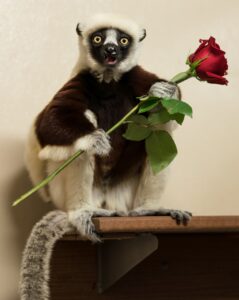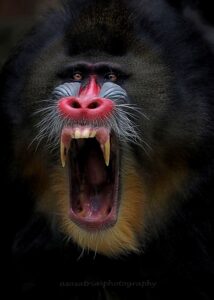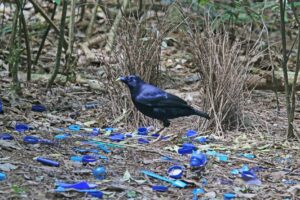Across the animal kingdom, love can be exciting, but also exhausting, dangerous, or even downright stinky! Of course, when we talk about “love” in non-human animals, we’re talking about the process of attracting mates, bonding with mates, and producing and caring for offspring. While there is incredible variation in the ways that animals go about finding “love,” one thing is certain – it’s not easy! Living organisms are motivated by one thing: continuing the species. In order to do that, organisms must survive long enough to reproduce, which usually means finding a mate. We find that hard enough in the human world, so how do animals find the best possible mates in the wild? It’s all about the attraction factor.

While a red rose may symbolize love for humans, this one just symbolizes a tasty snack for this Coquerel’s sifaka!
To understand how animals attract mates, it is important to try and understand what “attractive” means to an animal. To produce strong, healthy offspring, you need a strong, healthy mate – but strong and healthy looks completely different across species. One factor in animal attraction is physical size. Many species exhibit dimorphism, or differences in body size and shape, between males and females. Since females are the ones limited by how many babies they can have at a time, they typically are the ones doing the choosing, so they’re the ones to impress!
One common form of dimorphism is males having larger bodies or body features than the females. Larger size indicates success – eating well, staying healthy, and defending your territory are all key to growing larger. Adult male gorillas can be almost twice the size of adult females, and they act as the protectors of the females in their group. But it’s not always enough to have a large body. Male bighorn sheep, elk, and even stag beetles use their large antlers or horns both to attract females and to fight off competing males. The larger the horns, the more likely they are to win the fight and attract the females. In species where male competition is common, larger bodies, large horns, or impressive teeth are all part of the attraction factor. But bigger isn’t always better! During the Pleistocene epoch, a giant deer species called the Irish Elk boasted enormous antlers – most measuring around twelve feet long. Growing those impressive antlers would have taken a huge amount of resources and energy, and many scientists have speculated that this was the ultimate cause of extinction for the Irish Elk.

A reconstructed skeleton of a male Irish elk. (image source)
This might be why some animals instead turn to fashion to catch their potential partner’s eye. Many bird species exhibit brightly colored males and dull-colored females, but this phenomenon is also present in the primate family. Male mandrills sport bright, clownish facial markings which the females don’t have, but these males pair their statement look with a large body size and impressive canines, keeping them ahead of both the competition and potential predators. Bright colors, crests, manes, and other features that are “just for looks” can indicate that an animal is healthy and sexually mature, which are definitely attractive traits. However, bright colors can be a flag to predators in the area, so beauty can come at a price!

The bright coloration of the male mandrill is backed up by his large size and fearsome teeth. (image source)
For some creatures, looks aren’t everything. Many species have evolved complicated courtship behaviors to win over their potential mates, including mating dances, special songs, and even some impressive DIY. The bower bird is one of the most well-known for its unique way of attracting females – creating a bower, or a love nest, and decorating it beautifully. This process is time consuming and energetically expensive for the males, demonstrating his skill and strength to the female. While some bowerbirds use flowers, stones, and other colorful items, the Satin bowerbird has a very specific color scheme. Everything he collects is blue! Blue is a rare color in nature, which may be why it’s such a good color to show off. Just ask the blue-footed booby! Blue-footed boobies are well known for their mating dance, which is an excuse to draw attention to their bright blue feet. However, these courtship rituals aren’t just for the birds: pufferfish also create elaborate designs in the sand with their fins to attract females to come and visit.

This male satin bowerbird has assembled an impressive collection to attract a female. (image source)
Architecture, fashion, and dance moves aside, the most important part of any relationship is communication. Whether saying “I’m single and ready to mingle!” or something more complex, animals use many forms of communication to get their message across. More solitary or dispersed species may need to signal their presence to potential mates, either with a repetitive call or a complex song, but predators can hone in on these love songs just as easily. Scent-marking can provide additional information, such as whether the marker is in heat or healthy, and even some clues into their DNA! Research on ring-tailed lemurs suggests that their scent contains a genetic marker which helps the lemurs avoid pursuing their relatives. While scent is typically marked on territory, the ring-tailed lemur also prefers a more direct approach. Males will use their scent glands to anoint their tails, and flick the scent back and forth at each other in a competition called a stink-fight. Males may also “stink-flirt” by wafting their scented tails towards the female. Well, they say love stinks, right? Click here for an excellent article all about stink-flirting that includes great video!
The many strange and wonderful ways that animals attract mates teaches us a great deal about how certain physical characteristics and behaviors came to be. Some of the most marvelous aspects of nature likely came about as a way of flirting, from colorful feathers to glorious horns, from beautiful birdsong to goofy dances, and everything in between. No matter how strange some of these courtship displays may seem to us, the search for a mate has shaped much of animal evolution. After all, love makes the world go around!
Check out our sources for this article to learn more:
Allometry for Sexual Size Dimorphism: Pattern and Process in the Coevolution of Body Size in Males and Females. D. J. Fairbairn. Annual Review of Ecology and Systematics 1997 28:1, 659-687
Steven R. Leigh, Patterns of variation in the ontogeny of primate body size dimorphism, Journal of Human Evolution, Volume 23, Issue 1, 1992, Pages 27-50, ISSN 0047-2484.
Antler growth and extinction of Irish elk. Ron A. Moen,1 John Pastor and Yosef Cohen. Evol Ecol Res 1: 235-249 (1999)
O’Driscoll Worman, C. and Kimbrell, T. (2008), Getting to the hart of the matter: did antlers truly cause the extinction of the Irish elk?. Oikos, 117: 1397-1405.
Mitoyen, C, Quigley, C, Fusani, L. Evolution and function of multimodal courtship displays. Ethology. 2019; 125: 503– 515.
Cassini, M.H. (2020), Sexual size dimorphism and sexual selection in primates. Mam Rev, 50: 231-239.
Grogan, K.E., Harris, R.L., Boulet, M. et al. Genetic variation at MHC class II loci influences both olfactory signals and scent discrimination in ring-tailed lemurs. BMC Evol Biol 19, 171 (2019).
CHARPENTIER, M.J.E., BOULET, M. and DREA, C.M. (2008), Smelling right: the scent of male lemurs advertises genetic quality and relatedness. Molecular Ecology, 17: 3225-3233.
Male preference for female foot colour in the socially monogamous blue-footed booby, Sula nebouxii. Roxana Torres, Alberto Velando. Animal Behaviour. Volume 69, Issue 1, 2005. Pages 59-65. ISSN 0003-3472.
Kawase, H., Okata, Y. & Ito, K. Role of Huge Geometric Circular Structures in the Reproduction of a Marine Pufferfish. Sci Rep 3, 2106 (2013).

